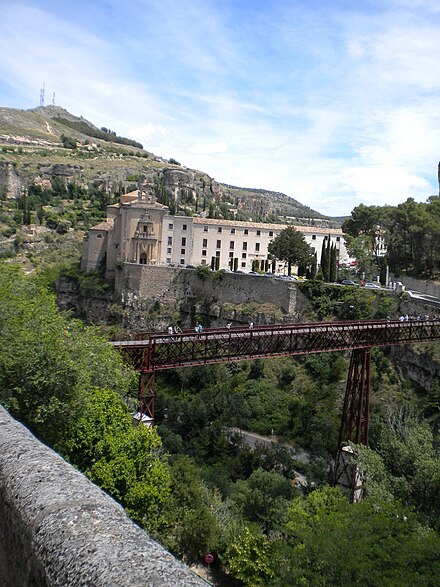See Cuenca (Ecuador) for another city named Cuenca.
Cuenca is a town in the Castile-La Mancha region of Spain. It's walled town is a UNESCO World Heritage site. The old town is an outstanding example of a medieval city, built on the steep sides of a mountain. The many casas colgadas ("hanging houses") are built right up to the cliff edge, making Cuenca one of the most striking towns in Spain.
Understand
Cuenca is found between Madrid and Valencia, in the third least populated region in Europe. It was home to about 55,000 people in 2018.
Cuenca sits across a steep spur, whose slopes descend into deep gorges of the Júcar and Huécar rivers. It is divided into two separate settlements: the "new" city is situated south-west of the old one, which is divided by the Huécar course.
Climate
Winters are relatively cold, but summers are quite hot during the day with occasional cool nights. Spring and autumn seasons are short, with pleasant temperatures during the day but with rather cold nights due to its altitude from 956 m (3,136 ft) above sea level up to 1,000 m (3,281 ft) in the old town.
Get in
By train
There are 2 railway stations in Cuenca. "Traditional" regional trains arrive to the "Estación de Cuenca" (~2 hr 50 min from Madrid) at the town centre. While "modern" AVE (55 min from Madrid) , Alvia and Itercity (~1 hr 10 min from Madrid) trains stop at the "Estación de Cuenca-Fernando Zóbel" 5 km from the town centre.
By bus
There is a coach station called Cuenca bus station in the centre of Cuenca that travels to nearby cities. Travel time to Madrid is approximately 2 hours and it is about the same travel time to Valencia, costing around €12.
By car
Distances to Cuenca: Madrid 165 km (1 hr 30 min), Albacete 145 km, Toledo 185 km, Valencia 210 km
Get around
Its best to go by car, but if you don't mind walking there is much that can been seen and done in the centre of town.
See
- Museum of Spanish Abstract Art, Calle Canónigos 16001, 40.078006°, -2.128694°, +34 969212983. Cuenca was the longtime home of artist and photographer Fernando Zóbel, and he chose it as the location for the museum, in two converted centuries-old "casas colgadas". Many of the pictures hang in glorious isolation with an entire wall for a single picture, and a few windows provide imposing views out over the gorge.
- Cathedral of Cuenca. Its façade is marred by a 19th-century attempt at remodeling, but has a beautiful Gothic interior with very detailed (and in some cases seemingly pagan) carvings. There is a near-absolute ban on photography, or even sketching, inside the cathedral, except by obtaining explicit permission, typically granted only on the basis of a portfolio.
- Museum of Cuenca, 40.077778°, -2.128611°. Dedicated largely to Roman finds in the area.
- undefined.


- The Castle: El Castillo is remains of an ancient Arab fortress, representing the older structures of Cuenca. Only a tower, two stone blocks, the arch which allows to enter/leave the old town from the Barrio del Castillo and a fragment of the walls have been left. The arch (arco de Bezudo) is named after Gutierre Rodriguez Bezudo, from Segovia, who fought the Arabs with King Alfonso VIII to conquer Cuenca. The castle was home of the Holy Inquisition after 1583, and it was destroyed during the 19th century by French soldiers during the Spanish War of Independence. Nearby are the small chapel and cemetery of San Isidro.
- Museo Paleontológico de Castilla-La-Mancha, Calle del Río Gritos, 5, +34 969 27 16 00. Museum of palaeontology featuring lots of lifesize dinosaur models. 2021-02-12
Do
See the hanging houses by the tourist train that leaves from the Cuenca tourist office on the hour every half an hour. If you have a car you can drive to some beautiful waterfalls in another part of Cuenca.
Buy
Because of the museum and because the town is a popular place for visitors from Madrid, Cuenca has a fine collection of small art galleries. You can collect Cuenca souvenirs in the tourist centre near town.
Eat
Most of the best restaurants are down below in the newer part of town, which is far less picturesque.
Alaju, Morteruelo, Ajo Arriero, Zarajos are the most typical foods
Drink
There are some lovely outdoor pubs in the old city of Cuenca. And a more trendy street in the center of town, filled with 10 to 15 clubs. There is also a massive square near this street where people hang out drinking alcohol with friends.
A high-alcohol-content liqueur named Resoli is a coffee-, anise- and orange-flavoured liqueur.
Sleep
Cuenca is a popular weekend destination, for lovers, artists and romantic people, so hotels are often less crowded during the week.
There is a hotel in the centre of town, its sign can be seen from far around Cuenca in all directions. If in doubt ask at the tourist office.
- NH Ciudad de Cuenca, Ronda de San José, 1, 40.0621581°, -2.13227°, +34 96 9230502. This hotel is in a new and calm residential zone, a few minutes away from the commercial centre, the old part of town and the intercity bus and railway stations of the capital.
There are some cheap hostels in town.
- Pension Central, Alonso Chirino 7, 40.0722754°, -2.1362588°, +34 969 211 511. Cheapest-priced at about €24 a double.
- Hostal Mora, Cjón. de San Francisco 1, 40.0710283°, -2.1353582°, +34 969 214 138.
Both are near the town center.
In old town
- Parador de Cuenca, Paseo del Huecar, 40.078989°, -2.126555°, +34 969 232320. single €128-138, double €160-175, breakfast €18, menue €33-45 (2013)